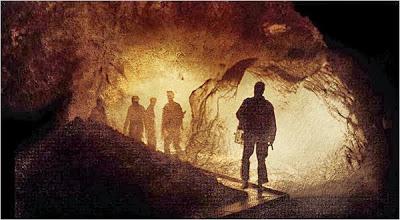Format: Streaming video from NetFlix on rockin’ flatscreen.

I have long had an interest in archeology. It’s not something I advertise, but it’s true. When I was in grade school, I had the chance to spend a week one summer at the Koster dig in Kampsville, Illinois. It was pretty damn cool, and while we didn’t do anything that really affected the dig, it was an experience that I won’t forget. When I went to grad school, my original major was in the Department of Anthropology. I find this stuff fascinating. When I saw that Cave of Forgotten Dreams was added to the list, I knew it was one I’d look forward to seeing.
The film concerns the discovery of the oldest cave paintings known. Located in what is now called Chauvet caves, the paintings are deep inside and perfectly preserved thanks to a rockslide that covered the entrance for tens of thousands of years. Because of this, the artwork was initially considered a possible forgery and only the thick deposits of minerals over the paintings verified their age of roughly 32,000 years.
Director Werner Herzog was given unprecedented access to the Chauvet caves with a small film crew. The caves are considered such a national, nay world, treasure that access to the inside is highly restricted. The caves are guarded and protected by an installed vault door that seals off the interior environment from external contamination. Once inside the cave, visitors are forced to don sterile garments and must remain at all times a on two-foot-wide catwalk. Herzog’s limited access—limited in terms of crew, positioning, and equipment—is still a remarkable opportunity to see these paintings in their real and natural environment.
Cave of Forgotten Dreams doesn’t attempt to tell a narrative tale. Instead, after giving us an extensive but never dull tour of the cave and some insight into its discovery, Herzog speaks to the various scientists who have also been given this opportunity to study the paintings, the geology, and the ancient bones of extinct animals now cemented to the floor.
Rather than manufacture a narrative, Herzog instead allows the scientists to discuss the various aspects of the cave that they have discovered. They offer ideas of how they believe the cave was used in the past, how the paintings were made, and even the order in which they were made. They discuss the discoveries in the art that have affected other fields of study. For instance, a particular painting of cave lions suggests that the species did not have a lion’s mane, since the depicted male does not have one.
The photography itself, for as limited as the technology was in terms of standard filmmaking, is simply breathtaking. This would be a film worth watching without a single minute of narration beyond a basic introduction and explanation of what we are seeing. Seeing the camera pan over these images hidden for literally millennia is more than enough to fill the 90 minutes of screen time. It is a trip through the most ancient of art museums, a journey back in time in all but the most literal sense.
There’s a part of me that wonders exactly how this film was packaged and sold to a wider audience. Documentaries in general are a tough sell, and those without an obvious conflict (or any conflict) are a tougher sell by several quantum levels. It must have been the power of the photography, or the deep, resident knowledge of someone in the film company itself that connected with these ancient and vital human artifacts.
Yes, I know I’m gushing about this, but it’s impossible to avoid. Herzog’s accented English seems to overlay this film perfectly, and I’m not sure it would be more effective coming from a narrator who spoke English as his or her native tongue. This is a film worth gushing about, especially for an archeology geek like me. I’ve sat in a 3x3 hole scraping out pot sherds that were deposited by natives of central Illinois 12,000 years ago. Those pot sherds and those natives are closer in time to me than they are to the paintings in Chauvet by a good 8,000 years. It’s difficult to contemplate that sort of time depth or to get a mental handle on it. These paintings were made in a time when wooly rhinoceros roamed in the south of France. It’s hard to get one’s mind around it.
Suffice to say that Cave of Forgotten Dreams is a must-see if only to get a real glimpse of this incredible human record. It’s the sort of thing that everyone should see and experience.
Why to watch Cave of Forgotten Dreams: It’s gorgeous.
Why not to watch: If you have fundamental beliefs about certain religious “truths,” you’ll have some problems here.
